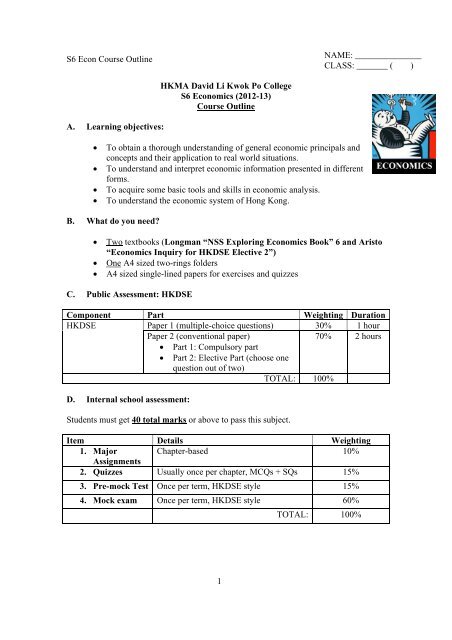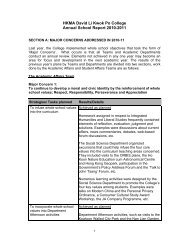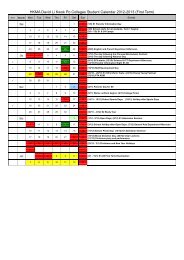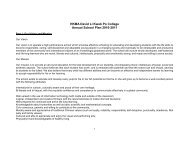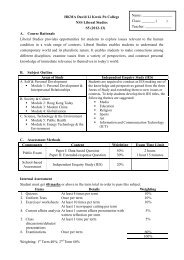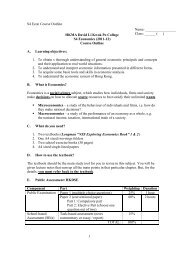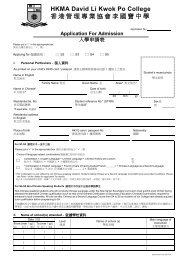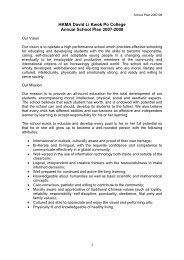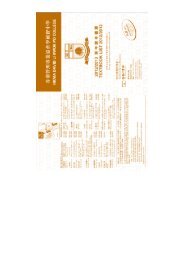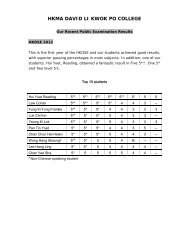You also want an ePaper? Increase the reach of your titles
YUMPU automatically turns print PDFs into web optimized ePapers that Google loves.
<strong>S6</strong> Econ Course OutlineNAME: _______________CLASS: _______ ( )A. Learning objectives:<strong>HKMA</strong> <strong>David</strong> <strong>Li</strong> <strong>Kwok</strong> <strong>Po</strong> <strong>College</strong><strong>S6</strong> Economics (2012-13)Course OutlineTo obtain a thorough understanding of general economic principals andconcepts and their application to real world situations.To understand and interpret economic information presented in differentforms.To acquire some basic tools and skills in economic analysis.To understand the economic system of Hong Kong.B. What do you need?Two textbooks (Longman “NSS Exploring Economics Book” 6 and Aristo“Economics Inquiry for HKDSE Elective 2”)One A4 sized two-rings foldersA4 sized single-lined papers for exercises and quizzesC. Public Assessment: HKDSEComponent Part Weighting DurationHKDSEPaper 1 (multiple-choice questions) 30% 1 hourPaper 2 (conventional paper)70% 2 hours Part 1: Compulsory part Part 2: Elective Part (choose onequestion out of two)TOTAL: 100%D. Internal school assessment:Students must get 40 total marks or above to pass this subject.Item Details Weighting1. Major Chapter-based 10%Assignments2. Quizzes Usually once per chapter, MCQs + SQs 15%3. Pre-mock Test Once per term, HKDSE style 15%4. Mock exam Once per term, HKDSE style 60%TOTAL: 100%1
<strong>S6</strong> Econ Course OutlineE. The topics to be taught this year:Topic:Time to bespent:1. Money demand and money market equilibrium 32. Monetary policy and quantity theory of money (QTM) 33. International Finance – exchange rate and balance of payments 24. Extension of trade theory 25. Economic growth and development 2Total: 12 weeksF. Summary of all topics in NSS Economics:Compulsory part:TopicA. Basic EconconceptsB. Firms andproductionC. Market andpriceD. Competitionand marketstructureDetails•Scarcity•Opportunity cost•Basic econ problems: what, how, for whom to produce?•Private property rights•Specialization and exchange•Circular flow model•<strong>Po</strong>sitive and normative statements•Types of business ownership•<strong>Li</strong>mited liability•Shares and bonds•Types of production•Producer goods, consumer goods, private goods, public goods•Division of labour•Factors of production•Short run and long run•Law of diminishing marginal returns•Economies and diseconomies of scale•Expansions of firms•Profit maximization•Law of demand / supply•Factors affecting demand / supply•Equilibrium, shortage and surplus•Consumer and producer surplus•Marginal benefit curve = demand curve•Marginal cost curve = supply curve•Function of prices•Changes in relative prices•Price elasticity of demand / supply•Market intervention: price ceiling, price floor, quota, unit taxand unit subsidy•Perfect VS imperfect competition•Definition of market•Features of different market structures•Sources of monopoly power2
<strong>S6</strong> Econ Course OutlineE. Efficiency,equity and therole ofgovernmentF. Measurement ofEconperformanceG. National incomedeterminationand price levelH. Money andbankingI. Macroeconomicproblems andpoliciesJ. Internationaltrade andfinance•Efficiency: maximizing total social surplus•Deadweight loss•Divergence between private and social costs (benefits)•Market VS government solutions•Efficiency VS equity•Lorenz curve and Gini coefficient•Sources of income inequality•Trade-off between equity and efficiency•GDP VS GNP•Three approaches: production, income and expenditureapproaches•Nominal and real GDP•GDP at factor cost•Per capita GDP; growth rate of GDP•<strong>Li</strong>mitations of using GDP statistics•Consumer Price Index VS GDP deflator•Unemployment and underemployment rates•Recent trends in HK•AD and AS curves•Reasons for a downward sloping AD curve•Reasons for a upward sloping SRAS curve•Reason for a vertical LRAS curve•Price and output level determined by AD-AS model•Definition and functions of money•Types and functions of banks, 3-Tier system in HK•Money supply in HK•Credit creation•Money demand: transaction and asset demands•Determination of interest rate by money demand and supply•HK as a financial centre•Business cycles•Inflation and deflation•Relationship between nominal and real interest rates•Redistributive effects•Quantity Theory of Money (QTM)•Unemployment and underemployment•Cost of unemployment•Fiscal policy: surplus, deficit and balanced budgets•Taxation principles, types of taxation•Public expenditure in HK•Monetary policy and the effects on price and output level•Free trades VS trade barriers•Absolute and comparative advantages•Principle of comparative advantage•Types and effects of trade barriers•Balance of payments•Exchange rates•The <strong>Li</strong>nked Exchange Rate System in HK3
<strong>S6</strong> Econ Course OutlineElective part 2:A. Extension oftrade theoryB. Economicgrowth anddevelopment•Production possibilities frontier•Comparative advantages and globalization•Changes in real GDP, per capita real GDP and HumanDevelopment Index•Factors affecting the growth of an economy: inputs andpolicies•Desirability and costs of economic growth•International / regional comparisonG. <strong>Po</strong>ints to Note:Students are required to keep all worksheets, handouts, assignments, andquizzes in a folder in an organized manner.Coping homework is strictly forbidden and offenders will incur penalties (e.g.black marks).Teacher may arrange learning activities outside classrooms during the termand students are encouraged to participate in these activities.Students are required to submit their assignments on time and there will bemarks deduction for late submission.Students should go to the classroom on time.Good luck in your HKDSE!4


